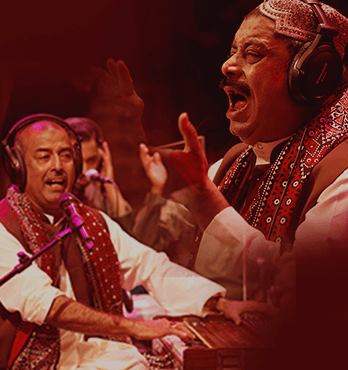Aadam

by Ayesha binte Rashid
In the cosmological order of the universe, it is often thought that music precedes mankind. It appears to be much like nature; existing in harmony with all living things long before we arrived. If we were to ask ourselves where music really comes from and where it has originated from, we would find that its existence stems from something intangible, just beyond our grasp, but we know it when we feel it or are in the presence of it.
Some say that music doesn’t come from us; it comes to us — from clouds talking in thunderous voices and leaves whispering secrets in the wind. For those who listen, one may find there is music in the cosmos that we can’t hear: time’s sands hissing steadily in its ever-constant hourglass and the inaudible humming of energy moving through our universe. We can only feel it in the rising and setting of the sun and the way death gives birth to life — when we pause to listen closely, in the beating of our hearts.
The Sufi tradition tell us that music is mankind’s Divine inheritance and a gift that was given to us at birth. It is said that it all began when our souls merged with the material aspects of our existence — it is the story of this primordial memory that Hazrat Amir Khusrow recalls in his couplet Aadam.
“Humankind has been created from clay and the spirit must merge with the clay container to bring it to life. Obviously, there is only darkness within the clay, no light. And the spirit is delicate; it is light, it refuses to descend into the clay because of the darkness,” Fareed Ayaz sums up the story of Aadam.
According to Sufi tradition, Noor (Divine Light) was placed within the clay container to drive away the darkness, Fareed Ayaz explains, and beautiful angels called out to Hazrat Aadam’s spirit. In a heavenly melody, the angels invited him into the Noor — the music moved Aadam to accept their invitation into his body and, as he did so, humankind came into existence.
As the story goes, the tradition tells us that when we descended onto Earth, we brought with us the memory of that heavenly music. This memory makes music a link between the past and present — it holds the power to thin the veil of material reality, awakening our primordial recollection of the Divine Source of our existence, linked as it is to that first memory. In certain Sufi traditions, such as the Chishti Order, music is a part of religious practice, a vessel that can invoke the Divine and carry the soul into a state of awareness.
As Fareed Ayaz takes his place on the takht, looking over the Coke Studio set, there is silence. The soundcheck is done and the camera is focused on Abu Muhammad and Fareed Ayaz, their pupils seated behind them. They begin the alaap as the house band waits. Eight voices climb, descend and on cue the orchestra swoops in, as their voices descend, catching them in an arrangement.
The troupe is singing in single syllables, words sometimes long and drawn out, sometimes too quick to discern. Fareed Ayaz begins to tell us the story of Aadam, a story that unfolds in breaks and repetitions, embellished with a tarana.
The tarana that we hear is one that was written by Khusrow specifically for a disciple who faced difficulty pronouncing certain words. This specific tarana is known as a talana and not once, during the entirety of the talana, do the singer’s lips meet - allowing for the words to easily roll off the disciple’s tongue.
The talana might seem like a string of single syllables joined together but, if one delves into the technicality of qawwali, one finds that nothing is out of place or without purpose in this arrangement. The syllables of a tarana are Arabic, Turkish, and Persian words that hold semantic value but have been altered; they are repeated like an incantation and carry mystical significance. As Fareed Ayaz tells us the story of Aadam, joining it with couplets that celebrate the Chishti Order and the famed musical gatherings of Hazrat Nizamuddin Auliya, the talana is often considered to draw one into a trance like state.
Our relationship with music is complex and multilayered - it mystifies humankind even as we learn to codify and curate it. As the Sufi tradition conveys, within a cosmos that moves to music, we have found in music a link to something greater than ourselves. And as the story of Aadam goes, therein lies the source of our collective Divine inheritance.
